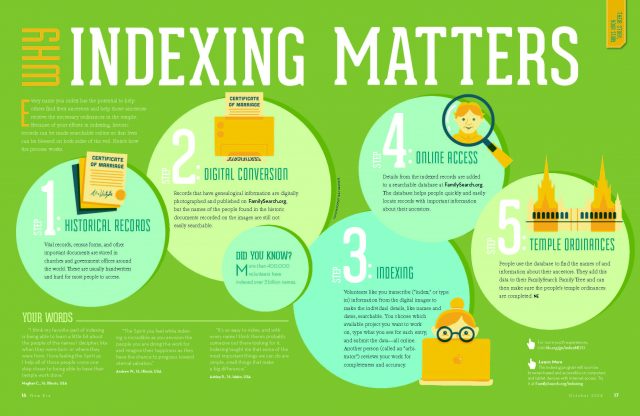Every name you index has the potential to help others find their ancestors and help those ancestors receive the necessary ordinances in the temple. Because of your efforts in indexing, historic records can be made searchable online so that lives can be blessed on both sides of the veil. Here’s how the process works.
Step 1: Historical Records. Vital records, census forms, and other important documents are stored in churches and government offices around the world. These are usually handwritten and hard for most people to access.
Step 2: Digital Conversion. Records that have genealogical information are digitally photographed and published on FamilySearch.org, but the names of the people found in the historic documents recorded on the images are still not easily searchable. Did you know that volunteers just like you have indexed over 8 billion names?
Step 3: Indexing. Volunteers like you transcribe (“index,” or type in) information from the digital images to make the individual details, like names and dates, searchable. You choose which available project you want to work on, type what you see for each entry, and submit the data—all online. Another person reviews your work for completeness and accuracy.
Step 4: Online Access. Details from the indexed records are added to a searchable database at FamilySearch.org. This database helps people quickly and easily locate records with important information about their ancestors.
Step 5: Temple Ordinances. People use this free database to find the names of and information about their ancestors. They add this data to their FamilySearch Family Tree and can then make sure the people’s temple ordinances are completed.
Try it at FamilySearch.org/indexing.
Testimonials from Latter-day Saint teens:
“The Spirit you feel while indexing is incredible as you envision the people you are doing the work for and imagine their happiness as they have the chance to progress toward eternal salvation.” — Andrew W., 16, Illinois, USA
“It’s so easy to index, and with every name I think there’s probably someone out there looking for it. Indexing taught me that some of the most important things we can do are simple, small things that make a big difference.” — Ashley R., 16, Idaho, USA
“I think my favorite part of indexing is being able to learn a little bit about the people of the names I decipher, like when they were born or where they were from. I love feeling the Spirit as I help all of those people come one step closer to being able to have their temple work done.” — Meghan C., 16, Illinois, USA
Watch a video invitation from President Russell M. Nelson at “Youth Connecting with Generations” and learn about simple things you can do to be a part of this great work.
This information was summarized and updated from the article “Why Indexing Matters” in the October 2014 issue of the New Era magazine.
The post Why FamilySearch Indexing Matters first appeared on LDS365: Resources from the Church & Latter-day Saints worldwide.Continue reading at the original source →




